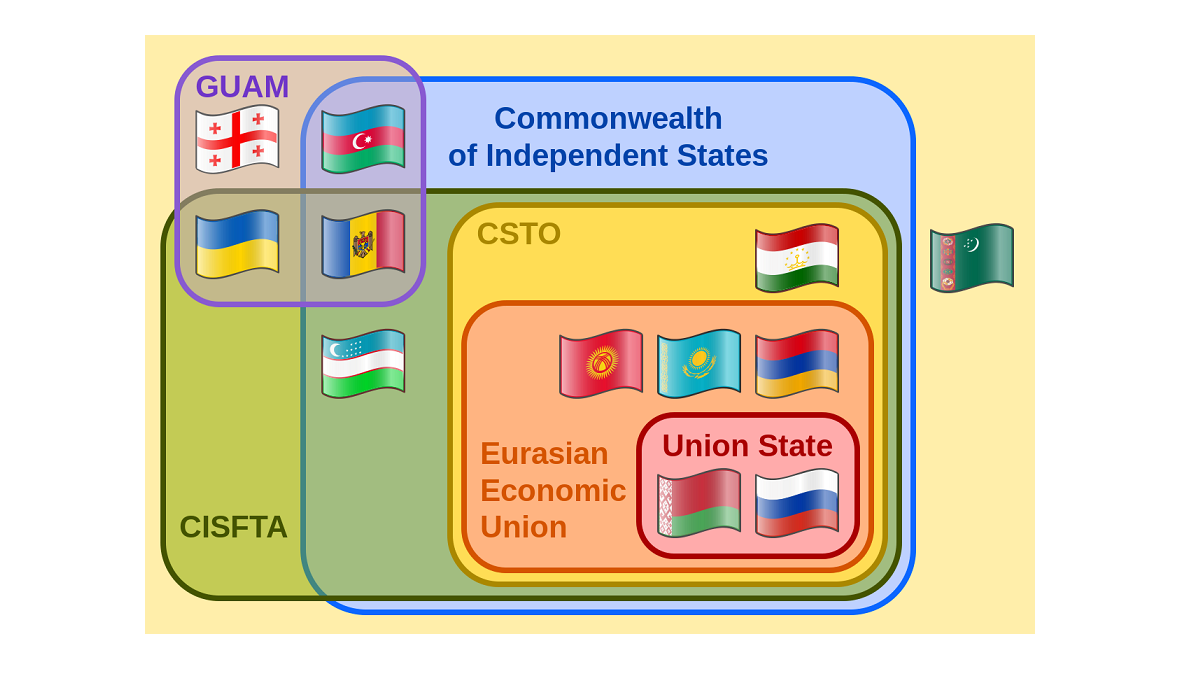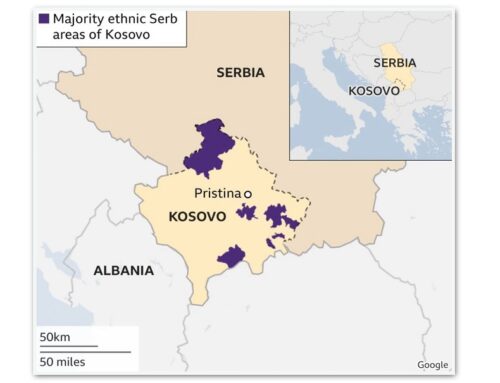Introduction
The geographical position of Belarus predetermines the need to implement a multi-vector foreign policy. At the same time, a paramount role in its formation is still played by the history of the Belarusian statehood and the process of development of foreign relations over the past century.
In general, the legacy of the USSR, international economic, political and humanitarian ties built during its existence continue to affect significantly the current state of affairs in the field of international relations in the CIS region. However, the current realities of the political landscape and the international agenda also have a direct impact on the level of contacts. In the post-Soviet period, several trajectories of the development of interaction between newly formed states can be traced.

Regional organisations and its members [1]
As for Belarus, since its independence, the country has consistently advocated the idea of the preservation of mutually beneficial partnerships. It is worth noting that the Republic of Belarus was among the initiators of the creation of the Commonwealth of Independent States and the termination of the existence of the USSR as a subject of international law [1]. The corresponding agreement was signed in Minsk in 1991. Subsequently, Belarus actively participated in the process of forming the organisation and ensuring its activities. Today, the Executive Committee of the CIS is located in Minsk.

Signing of the Belaveža Accords, December 8, 1991
Trade
The economic ties formed during the XX century, the geographical proximity of the countries preset mutual interest and the desire for trade and economic cooperation. In this regard, over the past decades, countries have been actively promoting integration projects, in which Belarus participated. Thus, Minsk became the founder of the Eurasian Economic Community (2000), the Customs Union with Russia and Kazakhstan (2009), the Free Trade Zone of the CIS member states (2011) [1], the Eurasian Economic Union (2014) [3].
The established organisations heavily contributed to the preservation of existing ties and the development of mutual trade in the region. Constructive cooperation in this area had a clear positive impact on the socio-economic situation, the movement of goods and services, capital and labor was noticeably simplified.
When assessing the results achieved within the framework of the above initiatives for Belarus, however, it is worth stressing the absence of a full-fledged common market within the EAEU. The presence of exemptions and barriers in mutual trade remains relevant, the created supranational institutions are extremely limited in their powers.
At the same time, it is important to emphasise that Belarus is an export-oriented state, as a result of which trade with the outside world is of particular importance for the formation of the country’s GDP. For example, according to the 2021 results, about 72% of GDP were covered by exports of goods and services [5]. In this regard, trade with the CIS countries, which are most closely connected with Belarus, is essential for Minsk. This region accounted for $49.9 billion in 2021, or 61% of the Republic’s foreign trade turnover [7].

Structure of the Belarusian foreign trade [2]
Particular attention should be paid to the fact that among the partner countries the Russian Federation stands out noticeably as the first trading partner of Belarus (49% of the total volume of foreign trade in goods of the Republic of Belarus by the end of 2021) and the main market for Belarusian goods abroad.
In this context, it is important to note that the formation of the Belarusian position on the need to participate in deep reintegration processes was largely influenced by the coming of A. Lukashenko to power in 1994. As for the current state of affairs, the events of the last two years have led to the highest rates of economic dependence of Minsk on Moscow in the entire history of the existence of an independent republic.

Signing of the Treaty on the creation of the Union State, December 8, 1999
It is also interesting that before the start of Russia’s full-scale invasion of Ukraine, Kyiv was the second partner of Belarus in terms of goods trade. Thus, by the end of 2021, the Belarusian-Ukrainian trade turnover amounted to $6.9 billion [6]. Today, trade relations between the countries are frozen.
Thus, in the current conditions of the regime of mutual economic restrictions and lack of political will for reconciliation, as well as the war initiated by Moscow, Minsk remains disconnected from the Western vector of its international economic relations and any ties with Ukraine. The current situation strongly contributes to the involvement of Belarus in closer integration processes with the CIS region, especially with Russia.
Military-political cooperation
Another crucial component of Belarus’ participation in integration processes in the region is membership in the Collective Security Treaty Organization, established in 2002 [4].

Online-meeting of the Heads of member states of the CSTO
An interesting fact is that the creation of the organisation was preceded by the Collective Security Treaty signed in 1992. Belarus joined it only in December 1993, because of the political course of the young Republic aimed at achieving the nuclear-free and neutrality statuses. At the same time, the resulting security vacuum was a reasonable ground for joining the treaty, which provided protection from partners in the event of external aggression.
When the Collective Security Treaty Organization was created, Belarus became its founder and remains its member to this day. Over the history of its existence, however, the CSTO has been repeatedly criticised for inefficiency by the Belarusian leadership. Such conflicts, however, were based on the nature of the political power of the organisation’s member countries and the contradictions between their leaders, in particular Belarus and Russia.
For example, in 2009, the conflict between Minsk and Moscow on mutual trade issues led to the refusal of the Belarusian side to participate in the creation of joint forces under the general command of the CSTO. Only after the resolution of the existing disagreements (about 5 months of disputes) Belarus has joined the Collective Rapid Reaction Forces of the CSTO.
In addition, it is worth paying attention to the protest expressed in 2010 by the Belarusian authorities due to the refusal of the CSTO to settle the internal conflict that broke out in Kyrgyzstan.
In the current state of affairs, the Belarusian leadership constantly emphasises its full commitment to participating in the organisation, adheres to the Russian narrative on issues of ensuring security and stability in the region. In general, it is more than difficult to imagine any other trajectory for the development of such a position in today’s circumstances.
Belarus — Russia
Despite the close cooperation with the countries of the region, the cooperation with the Russian Federation stands out with a special intensity of ties.
During the second half of the 1990s, a number of agreements were concluded aimed at the integration of Minsk and Moscow, the most significant of which is the agreement of December 8, 1999 on the creation of the Union State of Belarus and Russia (symbolically on the day of signing the Belaveža Accords) [2].

Development of Belarus-Russia relations in 1990s [3]
It is important, however, to note that due to changes in the political conjuncture, the project remained without due attention of the parties for decades. A special place in this issue was occupied by a number of conflicts between the leaders of the countries in the first half of the 2000s, and the rapprochement of Belarus with the EU in 2008-2010 and 2014-2020.
However, by the end of the 2010s, the Russian side intensified contacts to update the promotion of the project.
The events of 2020 in Belarus and its consequences greatly accelerated the integration: in November 2021, 28 ‘integration programs’ were approved, the preparation of the implementation of which lasted several years. At the same time, despite the increased dependence of Minsk on Moscow, the plans mostly include “harmonisation” and “unification” of national legislations mainly in the socio-economic sphere. The issues of creating unified institutions of power and currency were once again postponed [8].
Nowadays a new challenge to the preservation of Belarusian independence and sovereignty is the large-scale invasion of Russian troops into Ukraine. Despite the absence of direct participation of Belarusian troops in the war, the military sovereignty of the state is noticeably limited, the inability of the leadership to ensure the inviolability of the territory of the Republic is clearly demonstrated.
Sources:
- Commonwealth of Independent States // Ministry of Foreign Affairs of the Republic of Belarus. — https://mfa.gov.by/en/mulateral/organization/list/c2bd4cebdf6bd9f9.html.
- Belarus and Russia // Ministry of Foreign Affairs of the Republic of Belarus. — https://mfa.gov.by/en/bilateral/russia/
- Eurasian Economic Union // Ministry of Foreign Affairs of the Republic of Belarus. — https://mfa.gov.by/en/mulateral/organization/list/aa16658947a49c28.html.
- Collective Security Treaty Organization // Ministry of Foreign Affairs of the Republic of Belarus. — https://mfa.gov.by/en/mulateral/organization/list/cddd96a3f70190b1.html.
- Exports, percent of GDP – Country rankings // The Global Economy. — https://www.theglobaleconomy.com/rankings/exports/.
- Belarus and Ukraine // Ministry of Foreign Affairs of the Republic of Belarus. — https://mfa.gov.by/en/bilateral/cis/ukraine/.
- Belarus and CIS countries and Georgia // Ministry of Foreign Affairs of the Republic of Belarus. — https://mfa.gov.by/en/bilateral/cis/.
- Samorukov, Russia-Belarus Integration: Why Moscow Gained So Little // Carnegie Moscow. — https://carnegiemoscow.org/commentary/85749.
Diagrams:
- Aris Katsaris, Supranational post-Soviet bodies. — https://en.wikipedia.org/wiki/File:Supranational_PostSoviet_Bodies-en.svg#filelinks.
- General information: directions, tasks and results // Ministry of Foreign Affairs of the Republic of Belarus. — https://mfa.gov.by/en/export/foreign_trade/.
- “An Ever Closer Union?” // Netherlands Institute of International Relations Clingendael. — https://www.clingendael.org/sites/default/files/2021-08/an-ever-closer-union.pdf.


